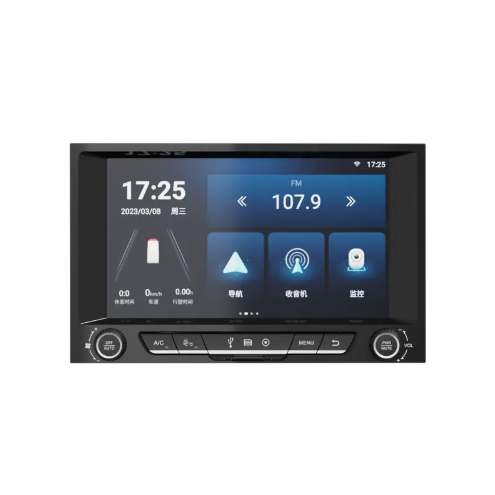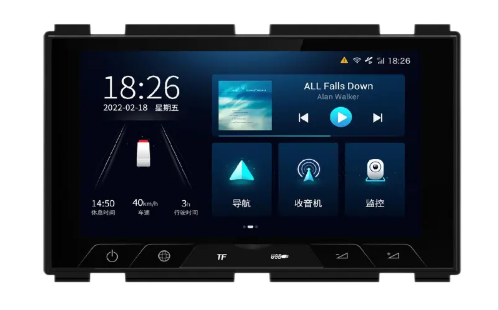Views: 0 Author: Site Editor Publish Time: 2025-09-25 Origin: Site
In the era of advanced automotive technology, the concept of the intelligent cockpit has emerged as a transformative element in vehicle design. An intelligent cockpit integrates cutting-edge technologies such as 5G, artificial intelligence (AI), and big data to create a seamless and interactive experience for drivers and passengers alike. This innovative environment not only enhances safety and comfort but also revolutionizes how users interact with their vehicles, making them more than just modes of transportation. As we explore the features and functionalities of intelligent cockpits, we uncover how these sophisticated systems are shaping the future of driving.
Intelligent cockpits have become the heart of modern vehicles, blending advanced technology to create a seamless, interactive experience for drivers and passengers. Three main technological pillars drive this innovation: 5G, artificial intelligence (AI), big data, and cutting-edge semiconductor processes, all integrated through sophisticated software and hardware systems.
5G technology revolutionizes vehicle connectivity by providing ultra-fast, low-latency communication. This allows real-time data exchange between the car, cloud services, and other devices. For example, 5G enables smooth streaming on infotainment systems and rapid updates for navigation or safety alerts.
AI powers the cockpit's ability to understand and predict user needs. It supports voice recognition, gesture control, and personalized settings, enhancing comfort and safety. AI algorithms analyze driving patterns, environmental data, and user preferences to adapt the cockpit environment dynamically.
Big data complements AI by collecting vast amounts of information from vehicle sensors, road conditions, and user behavior. This data helps improve system accuracy, optimize performance, and enable predictive maintenance.
An intelligent cockpit is a complex ecosystem where software and hardware work together seamlessly. The hardware includes displays, sensors, microphones, cameras, and control units. Software manages user interfaces, processes sensor inputs, and controls communication networks.
For instance, the Human-Machine Interface (HMI) relies on software to interpret voice commands or gestures and translate them into vehicle actions. Meanwhile, hardware ensures accurate signal capture and feedback, creating a natural and intuitive interaction.
This integration demands robust system architecture to handle high-speed data processing and maintain system stability, even under challenging driving conditions.
Semiconductors form the backbone of intelligent cockpit components. Advances in semiconductor technology enable smaller, faster, and more energy-efficient chips. These chips support high-density circuit designs critical for handling complex tasks like image processing for digital instrument clusters or real-time data encryption for security.
High-performance semiconductors ensure reliable operation of critical systems such as Advanced Driver Assistance Systems (ADAS) and multi-screen displays. They also contribute to reducing power consumption, which is vital for electric vehicles.
Manufacturers often use specialized materials and fabrication techniques to produce chips that withstand automotive environments, including temperature extremes and vibrations.
Selecting semiconductor components with automotive-grade certifications is crucial for ensuring long-term reliability and safety in intelligent cockpit systems.

Intelligent cockpits transform vehicles into interactive spaces, enhancing safety, comfort, and entertainment. Their applications span several key areas:
The HMI is the cockpit’s communication bridge between humans and the vehicle. It includes touchscreens, voice recognition, and gesture controls. These systems make driving safer and easier by allowing hands-free commands and intuitive interactions. For example, voice commands can adjust navigation or climate control without distracting the driver. Gesture controls enable quick actions like changing music or answering calls with simple hand movements.
Modern intelligent cockpits offer advanced entertainment options. High-resolution multimedia screens, surround sound systems, and streaming services keep passengers engaged. These systems rely on stable, low-power frequency control components to deliver smooth video playback and crisp audio. Passengers can enjoy movies, music, and games, making long trips more enjoyable.
Connectivity is vital for today’s vehicles. Intelligent cockpits integrate 5G and Wi-Fi to provide seamless internet access. This allows web browsing, video conferencing, and real-time updates for navigation or traffic alerts. Precise and stable frequency control components ensure reliable wireless connections, reducing interruptions during travel.
ADAS enhances safety by assisting drivers with features like lane keeping, adaptive cruise control, and collision warnings. These systems require high-performance, temperature-resistant components to operate reliably under harsh conditions. Intelligent cockpits integrate ADAS data into displays, giving drivers timely alerts and improving situational awareness.
For B2B automotive developers, selecting high-quality, automotive-grade crystals and oscillators ensures reliable performance across HMI, entertainment, connectivity, and ADAS functions in intelligent cockpits.
The journey of car cabins has evolved dramatically over time, shaping the intelligent cockpits we see today. This evolution can be divided into three major stages:
Before the 1980s, car cabins were mostly mechanical. Drivers relied on physical dials, gauges, and simple audio devices. Interaction was straightforward: drivers issued commands manually using buttons and knobs, while the vehicle responded passively. There were no display screens or integrated systems, and the cabin’s primary function was basic vehicle operation monitoring.
From the 1980s until around 2015, cabins started to embrace electronics and sensors. The rise of chip technology allowed digital instrument panels to replace many mechanical components. Small LCD screens appeared, offering more information and some entertainment options. Voice controls and other non-contact interactions began to emerge, improving convenience and safety. This stage marked the beginning of networking and smarter human-machine interaction in cars.
Since 2015, car cabins have transformed into fully intelligent spaces. Multiple integrated screens and smart devices create a connected environment for drivers and passengers. The cockpit now supports entertainment, navigation, office work, and social interaction. Human-machine interaction has diversified, shifting focus from just the driver to all occupants. Features like AI-driven voice recognition, gesture control, and multi-screen displays define this stage, making cars more than transportation—they become mobile smart spaces.
Understanding these development stages helps automotive developers design intelligent cockpits that meet modern user expectations for connectivity, safety, and comfort.
The intelligent cockpit in modern vehicles depends heavily on sophisticated printed circuit boards (PCBs). These PCBs serve as the backbone for integrating multiple electronic functions, enabling smooth communication between hardware components and software applications. They handle everything from infotainment and driver assistance to vehicle connectivity through the Human-Machine Interface (HMI).
Central control displays have replaced many traditional physical buttons on dashboards. These displays are usually high-resolution LCD touchscreens that require PCBs capable of high-density interconnect (HDI) designs. HDI PCBs allow complex signal processing and high-speed data transmission, ensuring responsive touch control and seamless operation of multimedia systems.
Digital instrument clusters replace mechanical gauges with vibrant TFT LCD or OLED screens. The PCBs for these clusters must support high integration and maintain excellent signal integrity to display real-time vehicle data accurately. This includes speed, fuel levels, navigation, and safety alerts, all presented clearly and reliably to the driver.
HUDs project critical driving information onto the windshield, allowing drivers to keep their eyes on the road. PCBs in HUD systems support high-performance signal processing and optical projection technologies. They ensure stable, clear visuals by managing the complex data streams and lighting control needed for this advanced display.
Modern intelligent cockpits often feature multiple screens—central consoles, instrument clusters, and passenger displays. PCBs must handle data synchronization across these screens, requiring exceptional signal integrity and anti-interference capabilities. High-quality automotive PCBs ensure smooth interactions and consistent performance across all displays.
Voice and gesture controls are becoming standard in intelligent cockpits, powered by AI. These features require PCBs that support high-speed signal transmission and powerful computing units. The PCBs must handle complex audio and sensor data quickly and accurately to execute commands without delay, enhancing safety and convenience.
To meet the demands of intelligent cockpits, PCBs must have:
● High-Density Interconnect (HDI) Design: Enables compact layouts and reduces signal interference.
● Multi-layer Structure: Supports complex circuits and improves stability.
● Low Dielectric Loss Materials: Enhances signal transmission efficiency at high frequencies.
● High-Temperature Resistance: Ensures reliability in harsh automotive environments.
● Flexible PCB Options: Allows integration in curved or compact spaces like cameras or curved displays.
Manufacturers often use automotive-grade materials and follow strict quality standards to ensure durability, safety, and long-term performance. These PCBs are essential for creating a seamless, intelligent driving experience.
For B2B automotive developers, selecting PCBs with high-density interconnects and automotive-grade materials is crucial to ensure reliable performance and longevity in intelligent cockpit applications.

Intelligent cockpits are evolving rapidly, transforming how drivers and passengers interact with vehicles. Several key trends are shaping the future of these smart environments, emphasizing larger displays, multi-mode interaction, and brand differentiation.
The shift from physical buttons to large, integrated screens is a defining trend. Vehicles now feature expansive central control displays that combine multiple functions into one interface. Multi-screen setups are becoming common, including instrument clusters, central consoles, and passenger displays. This multi-screen environment allows for better data presentation and richer interaction, enhancing user experience.
For example, Tesla's Model S popularized the large 17-inch central touchscreen, setting a new standard. Other manufacturers follow by integrating multiple high-resolution screens that offer seamless content sharing and synchronized controls. This approach reduces clutter and creates a modern, futuristic cabin feel.
Safety and convenience drive the move toward multi-mode interaction. Voice control has become the primary hands-free method, allowing drivers to operate navigation, media, and climate systems without taking their eyes off the road. However, voice alone cannot address all interaction needs.
Gesture recognition and facial expression detection are emerging as complementary interaction modes. They provide intuitive control options, such as swiping in the air to change music or using facial cues to adjust settings. Combining voice, gesture, and face recognition creates a multi-modal system that adapts to user preferences and driving conditions, making interactions more natural and personalized.
Automakers face challenges in autonomous driving technology development due to regulatory and technical hurdles. The intelligent cockpit offers an alternative way to stand out in a competitive market. By investing in innovative cockpit features, brands can differentiate themselves and influence purchasing decisions.
Unique interface designs, exclusive software features, and superior interaction modes help create a distinctive brand identity. For instance, some manufacturers emphasize luxury with OLED curved displays and advanced HUDs, while others focus on connectivity and AI-driven personalization. Intelligent cockpits become a key battleground for innovation and customer loyalty.
For B2B automotive developers, prioritizing flexible multi-screen designs and integrating diverse interaction modes like voice and gesture control can significantly enhance user engagement and brand appeal in intelligent cockpits.
Intelligent cockpits, driven by 5G, AI, and big data, revolutionize vehicle interaction. These systems enhance safety, comfort, and entertainment through seamless software and hardware integration. Advanced semiconductors and PCBs support high-performance features like HMI, ADAS, and network connectivity. Future trends include larger screens and multi-mode interaction, offering unique brand differentiation. Companies like Hangzhou HopeChart IoT Technology Co., Ltd. lead this innovation, providing cutting-edge solutions that elevate the driving experience and set new industry standards.
A: An Intelligent Cockpit is a technologically advanced vehicle cabin that integrates 5G, AI, big data, and semiconductor processes to enhance driver and passenger interaction, safety, and comfort.
A: Intelligent Cockpits use AI for voice recognition, gesture control, and personalized settings, analyzing data to adapt the environment dynamically, improving comfort and safety.
A: 5G is crucial for Intelligent Cockpits as it provides ultra-fast, low-latency communication, enabling real-time data exchange for infotainment and navigation systems.
A: Intelligent Cockpits offer improved safety, comfort, and entertainment through advanced Human-Machine Interfaces, electronic entertainment systems, and ADAS integration.
A: Unlike traditional cabins, Intelligent Cockpits feature integrated screens, AI-driven interactions, and seamless connectivity, transforming vehicles into interactive smart spaces.

